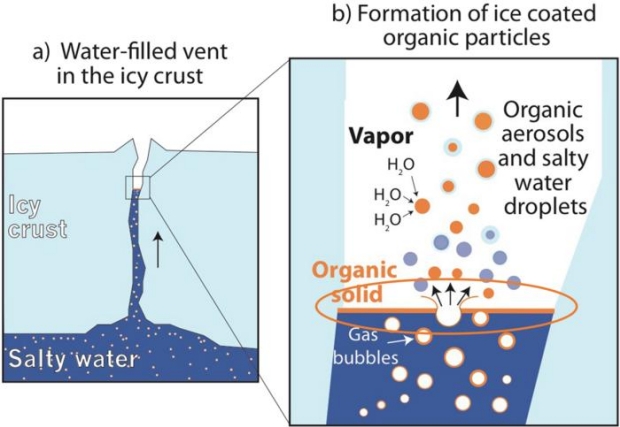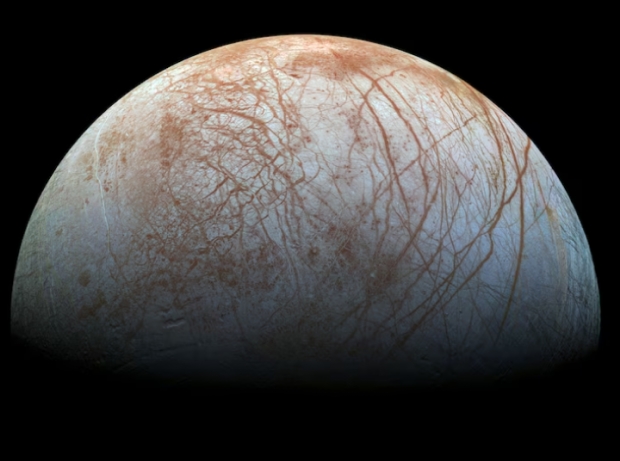Europa Clipper is scheduled to launch on October 10, with arrival at Jupiter in 2030. That will keep subsurface oceans on our minds as we tangle with the problems of analyzing water locked under kilometers of ice. Some moons, of course, help us out. Enceladus spews watery materials into space through cracks in its crust, making flybys through its geysers a possibility for snagging samples. Europa Clipper may find further evidence of the much less dramatic plume activity that has been spotted on Europa. Clipper’s SUrface Dust Analyzer (SUDA) would prove vital in such analysis.
If cellular material is found in an ice grain snared from an orbital pass, would we be able to detect it? The answer may be found in laboratory work with a common bacteria that thrives in the waters off Alaska. As explained in new work out of the University of Washington and the Freie Universität Berlin, the bacterium Sphingopyxis alaskensis is made to order for such studies. It is smaller than Escherichia coli (frequently used in experimental work), thrives in cold conditions and needs little by way of nutrients to stay alive. If you want to approximate an icy moon’s ocean environment and experiment here with how life might operate there, Sphingopyxis alaskensis is just the ticket.
Under the direction of lead author Fabian Klenner (University of Washington), a research team has been pondering how material ejected from a moon like Enceladus might be detected by a spacecraft passing through a plume. The benefits of analyzing materials from subsurface oceans without landing are obvious, although Enceladus presents a much more benign environment for surface investigation than Europa, given the vents in its south polar crust and its much lower radiation exposure. And even if you find a way to shield a Europa lander, how to drill through all that ice?
The challenge the team has overcome is how to simulate ice grains impacting a scientific instrument at between four and six kilometers per second. The proposed solution: Fire a beam of liquid water into a vacuum. As it transforms into droplets, deploy a laser beam to excite the droplets and subject the result to mass spectral analysis, which identifies chemical and isotopic compositions. Europa Clipper’s SUrface Dust Analyzer will be able to detect ions with negative charges, even fatty acids and lipids. Thus the prospect of flying through a Europan plume looms as an exciting astrobiological possibility.
The genesis of this work comes from the authors’ analysis of Enceladus, in which they examined the evidence for phosphates in its ocean. The moon appears to contain the organic materials and the energy resources needed to support some form of life. Indeed, that work, developed in a 2023 paper, found that phosphate is present in the Enceladus ocean at levels at least 100 times higher, and perhaps much higher still, than in Earth’s oceans. Phosphates are vital to life on Earth, and this work was the first report of direct evidence of phosphorus on an icy moon. As Klenner noted then:
“By determining such high phosphate concentrations readily available in Enceladus’ ocean, we have now satisfied what is generally considered one of the strictest requirements in establishing whether celestial bodies are habitable.”
So we have an ocean laden with recently discovered dissolved phosphates, one with previously known dissolved carbonates and a variety of other carbon-containing compounds and salts. Bacterial cells found here, if encased in a liquid membrane, might well rise through cracks in the ice shell even as exposure to the vacuum would cause the waters directly below to boil. Gas bubbles bursting at the surface would allow cellular material to become incorporated into ice grains being blown outward by the plume. That’s a scenario that makes for possible life discovery.
As the paper notes:
Although an extraterrestrial biosphere might use different biochemistry, it is logical to assume an aqueous-based ecosystem with access to molecular building blocks common in our Solar System [e.g., amino acids, aliphatic hydrocarbons, sugars, nitrogen heterocycles, and others commonly found in meteorites (69)] would likely use and modify the concentrations of those molecules in ways that would deviate from an abiotic system (57, 70).

Image: The left panel shows the kilometers-thick icy crust believed to encapsulate Saturn’s moon Enceladus. Filling the crack is salty water with a proposed thin layer (shown orange) at its surface. The right panel shows that as gas bubbles rise and pop, they combine with organic material and get lofted into the spray. Credit: Postberg et al. (2018)/Nature.
The experimental results in the recent lab work on Sphingopyxis alaskensis are encouraging. The above mechanism would produce enough material in individual ice grains for cellular matter to be detected by instruments like those aboard Europa Clipper and future missions to icy moons. Indeed, a single ice grain would do the trick. Says Klenner:
“For the first time we have shown that even a tiny fraction of cellular material could be identified by a mass spectrometer onboard a spacecraft. Our results give us more confidence that using upcoming instruments, we will be able to detect lifeforms similar to those on Earth, which we increasingly believe could be present on ocean-bearing moons.”

Image: Won’t it be great when we can move past the old Galileo imagery of Europa for fresh images taken by Europa Clipper? This Galileo image shows red streaks across the surface of this smallest of Jupiter’s four large moons. New research shows that one of the instruments destined for the Clipper mission could find traces of a single cell in a single ice grain ejected from the moon’s interior. Credit: NASA/JPL/Galileo.
The paper is Klenner et al., “How to identify cell material in a single ice grain emitted from Enceladus or Europa,” Science Advances, Vol 10, Issue 12 (22 March 2024). Abstract. The paper on phosphates on Enceladus is Postberg et al., “Detection of phosphates originating from Enceladus’s ocean,” Nature 618 (14 June 2023) 489-493 (abstract).



It is very encouraging that the instruments on Europa Clipper are able to identify organic compounds, even complex ones, rather than much simpler ones from previous missions. Fragments of DNA/RNA, proteins, sugars, and lipids would be potentially indicative of life.
I am not clear why the phosphorus content of the oceans is important. Phosphates are likely to exist from rock weathering. What is important is bound phosphorus to manage an energy source and use. The energy flow is the most important factor, and that may be very limited from the geology.
The Klenner paper in Science Advances is open access and not just the abstract.
I always thought this was a great idea. I would like to see the mechanics of how they get the spacecraft with the mass spectrometer into low orbit around Europa. It might need some rocket fuel and thrusting to get the right orbit or at least have that capability if they want to change it’s orbit and fine tune it.
Europa Clipper won’t be going into orbit around Europa. The radiation environment is simply too extreme. Instead, it will be doing a series of flybys. Its orbit will be around Jupiter.
Listening to the SETI: Live talk on the subsurface ocean of Mimas, it was suggested that this ocean is very young: perhaps 5-15 million years old. If so, this would seem to rule out abiogenesis as the time seems very short to evolve the needed chemistry and information storage.
Which brings me to ask: “Do we know how old Europa’s and Enceladus’ oceans are? Are we talking billions of years, hundreds of millions, or just tens of millions of years old?”
I think it was within 500K years of the moon’s formation.
https://www.science.org/doi/10.1126/sciadv.adf3955
I don’t agree with the video where a scientist says that a zero orbital eccentricity would mean that Mimas would not have any oceans. AI chat GPT source and also Google. Mimas was there before Saturn’s rings which are thought to be only 400 million years old according to NASA. According to Wikipedia, that Mimas lack of cratering means it’s surface is only 25 Million years old which would have to be the result of subsurface oceans. Interesting. Due to tidal heating, there would be more than enough time for life to form considering it could form without any light.
An eccentricity of zero would not mean that Mimas could not have any subsurface oceans. AI chat GPT. I agree with that.
Extremophiles on Europa:
https://youtu.be/Lyq3e8i5Nxo
From this article:
https://www.universetoday.com/166436/extremophiles-why-study-them-what-can-they-teach-us-about-finding-life-beyond-earth/
https://astrobiology.com/2024/08/the-astrobiological-potential-of-the-uranian-moon-system.html
The Astrobiological Potential of the Uranian Moon System
By Keith Cowing
Status Report
Astrobiology via PubMed
August 27, 2024
The 2023-2032 Planetary Science and Astrobiology Decadal Survey prioritized the Uranus Orbiter and Probe (UOP) mission concept as the next priority flagship mission. The UOP concept includes scientific studies of the Uranian moon system.
Although the Uranian moons differ greatly from the ocean worlds in the Jovian and Saturnian systems, the emerging hypothesis is that some of them could at least sustain thin, potentially concentrated, oceans.
Herein, we make a case that these moons are important and interesting targets of astrobiological research. Studying these worlds would provide critical astrobiological data related to their habitability, including origin, evolution, and potential death, as well as the formation and evolution of ocean worlds more broadly.
There is a strong need for research that connects astrobiology to modeling and experimentation to better characterize the possible conditions of these worlds, and this will be critical in formulating and maximizing the potential science that could be done by a Uranus flagship mission.
Jessica M Weber, Erin J Leonard
The Astrobiological Potential of the Uranian Moon System, Astrobiology via PubMed:
https://pubmed.ncbi.nlm.nih.gov/39159442/